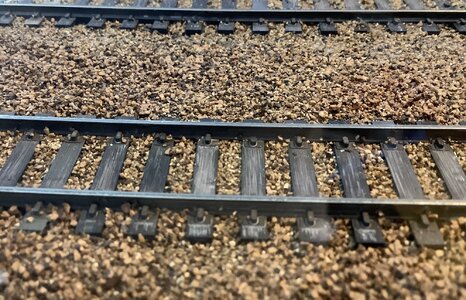Regarding the ballast, don't put quite so much in the center, leave a slight depression. I use an old 3/4" paintbrush to spread it and get most off the tie tops. Once I get the glue/water/ few drops of Dawn detergent mixture applied after wetting everything with rubbing alcohol/water, if that's what you use, fold up a paper towel and blot the ties, brushing off the towel between blots. That will get rid of most of the stuff on top of the ties. After 35 years, I still get some stuck to the inside of the rails which I remove using a small screwdriver as a chisel. Dental picks are just as effective.
Regarding
Curt's comments. His idea about using the painter's tape works, but I feel that it is an extra step. I use the same 3/4" brush to brush the ballast into my preferred profile before wetting it down. I don't have a problem with excess ballast and I just bring my ground cover up to where I want it when I do that later. I find it easiest to use recycled take-out condiment cups, which are essentially smaller Dixie cups.
Regarding
Crandell's comments. To me, HO scale roadbed is too high and too wide for sidings, so I use unsplit N scale on them. It takes a little extra ballast to obtain the right profile, but again I use that 3/4" brush to position everything. In reality, on the BNSF roadbeds near me, the main line ballast looks wider than my layout ballast. Coarse ballast is too large for HO. Medium is better although honestly it is actually too large scalewise as well. But it looks OK. Here is an example using Woodland Scenics medium light gray on the main with the HO cork roadbed, alongside a passing siding using unsplit N scale cork roadbed and medium WS mixed gray.
That's a homemade mix of different WS browns with a little gray mixed in, in between and alongside the main. I probably used some fine browns in the mix as well as medium.
I am not being critical of anyone else's methods, just posting what works best for me.
Another shot of a different spot on the layout which shows the elevation difference better.
Hope that this helps.


